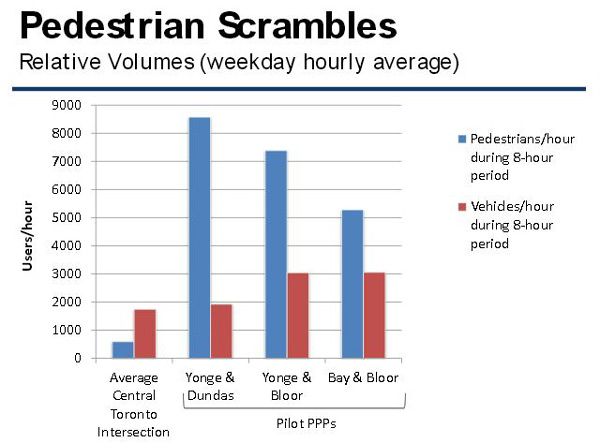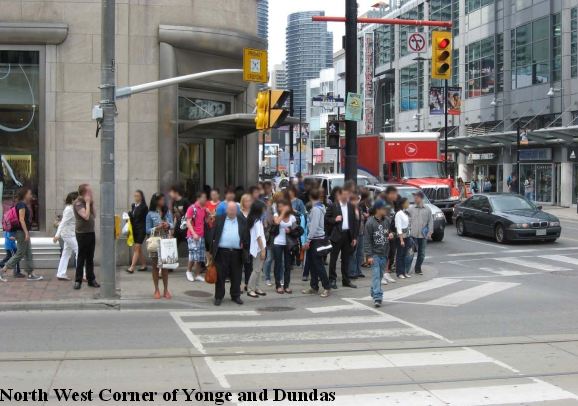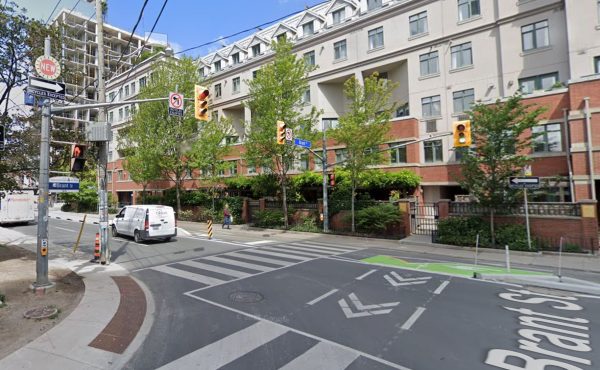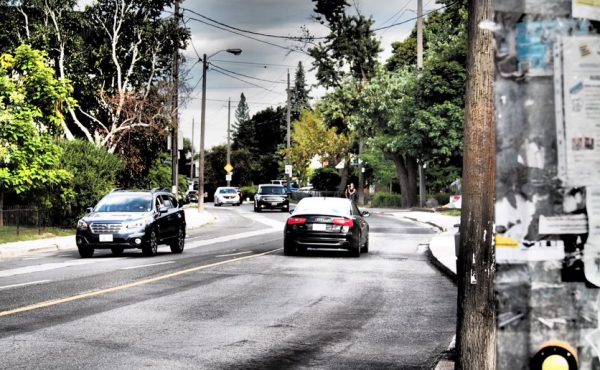Last night I attended a public meeting about changes to the intersection of Bay and Bloor, including a proposal by the City to remove the pedestrian scramble. Opinions at the meeting seemed divided about evenly between those who wanted to remove it (mostly local residents frustrated by traffic delays) and those who wanted to keep it (including some local residents who pointed out that the number of people living — and walking — in the area is set to increase significantly as new condo buildings go up).
The City wants to remove the scramble because they have done a study that shows it is under-performing compared to the other two scrambles (Bloor/Yonge and Yonge/Dundas). The City says that, unlike to the other two, few pedestrians use the diagonal there, it’s not heavily used outside peak hours, there is no danger of crowding because the sidewalks are wide, and the traffic delays it causes are more severe.
Unfortunately, the City has not actually released this study, so there was no information for the public to judge for themselves the City’s assertions. The chart above comparing pedestrian and car numbers was the only set of numbers provided. It really doesn’t seem viable to make this decision, or even for the public to comment on it, until the actual numbers are available. Releasing the study would also, from what was said at the meeting, show that the other two pedestrian scrambles are working well.
As well, the study would provide the basis for a set of criteria to look for alternative intersections where scrambles would be successful. Experience with pedestrian streets has shown that it’s not worth implementing pedestrian infrastructure unless it’s viable — some poorly thought-out early pedestrian malls discredited the concept until better-considered ones showed they could be successful. In Toronto, for example, testing three university pedestrian streets showed that two were successful (Gould and Willcocks) while one wasn’t (Devonshire) and was not continued. People might be more willing to consider losing a scramble if they can see a commitment to keeping the successful ones and finding locations for new ones where they will be more successful.
The City really needs to release the full study before making a decision, needs to reiterate its commitment to at least the two clearly successful scrambles, and needs to use this opportunity to establish the criteria for adding new ones in the future.
One last item — a few people at the meeting said that the scramble should work like older ones in some other cities, where pedestrians can only cross on the all-directions phase and cars can turn freely during their phase. The point of the Toronto scrambles is to provide better service for pedestrians at intersections where they significantly outnumber vehicle traffic. Restricting them to only one cycle would actually create worse service to the pedestrians who are the majority users of these intersections, who would have to wait for two whole cycles before they crossed (a longer wait even if the traffic cycles were shortened).
Not only would it be a bad experience in retail districts where the pedestrian experience is part of their appeal, but studies have shown people would be more likely to get impatient and try to cross against the red, creating a safety problem. As well, it would make the crowding that happens at these intersections (see photo above), with people spilling out onto the street while they wait, much worse (bear in mind that reducing this dangerous crowding was a key reason for implementing the scrambles in the first place). Finally, at Yonge and Dundas, there were already no turns allowed at all before the scramble went in, and they were already heavily restricted at Yonge and Bloor, so turning is not really an issue at these core scramble intersections. City staff also emphasized that the CNIB, in consultations, was strongly against this concept because it would run against the traffic training of the visually impaired. The pedestrian-priority scramble has been clearly successful in at least two intersections in Toronto, improving safety and the experience of the pedestrian majority of users and creating some excitement — it makes sense to keep these at least, and figure out where else it would be successful too.
Photo and graph from City of Toronto.







22 comments
An important consideration in the degree to which scrambles are used is certainly the storage capacity of sidewalks at the corners, but also the probability that the signal is actually useful to someone arriving there. When I arrive at Bay and Bloor (say), my destination will be one of the far corners (cross east-west, north-south or diagonally). Only if I need a diagonal crossing will that phase be of direct use, but the “all walk” is also used for EW and NS crossings.
If I arrive at the start of a green traffic phase, I am not going to wait for the all walk because I can simply make two “normal” crossings without having to wait at all. If the phases are all the same length, and I always want to make a diagonal crossing, I will only use the scramble 1/3 of the time. If the EW and NS greens are longer (for the autos) this reduces the likelihood that the all walk will be the option that greets me as I arrive at an intersection.
The low usage may be as much a question of timing and convenience as anything else, but it is quite noticeable that Bay-Bloor has much less diagonal traffic than Yonge-Bloor or Yonge-Dundas.
Dundas & Spadina? Talking about serious crowding there. But then right turn there is almost impossible already.
I do think that the length of the crossing has an impact, both on pedestrians being willing to use it and certainly on traffic delays (needs longer phase), and that’s part of the issue at Bay and Bloor. So Spadina is probably out of the question, unfortunately. Yonge works well because it’s actually quite narrow.
Devonshire is still closed off. Is it not being pedestrianized?
There should be no pedestrian walk when the car traffic is in use. At the same time, cars should be able to make right turns, if there is no pedestrian signal. Then the pedestrian scramble should be in force to stop traffic in ALL directions including turns. Pedestrians should only cross the intersection ONLY on the scramble. In addition, no scramble at low use times, such as 4 AM in the morning, and other times depending upon the volume.
the one thing that bothers me with Scrambles is how they make driving a car around even worse.
Personally, I would prefer the 4 way scramble to be a little longer and the only time pedestrians get to cross the road, with traffic being unimpeded the rest of the time
I have to admit I feel quite silly crossing this intersection diagonally late at night and watching the line of taxis wait for me to cross. The largest difference I have seen between this scramble and the other two in the city is that pedestrian use seems to drop off heavily overnight.
Is there any thought of just limiting the diagonal phase of the light to the daytime hours?
Would it be overthinking the issue to suggest that they enable the scramble at peak pedestrian times and disable it at non-peak times?
Also, to the suggestion of Dundas and Spadina above: the problem with this is that two streetcar routes run through that intersection and an additional signal phase would create a huge bottleneck for public transit there.
@the lemur If I’m not mistaken, Devonshire is closed off to accommodate construction of an athletics building across from Varsity Stadium.
Cross-posted and edited for Spacing:
The city staff and BIA who favour removing the Scramble make the mistake of assuming the Scramble is for pedestrians. It is equally to the benefit of traffic when implemented correctly, and not lacking a key element like at Bloor & Bay: traffic only phases E-W & N-S that permit exclusive and free-flowing right turns.
1) E-W Traffic ONLY;
2) N-S Traffic ONLY;
3) Pedestrian Scramble.
This will allow ALL traffic to clear the intersection every time all the way backed up to Avenue or Yonge (for example). I don’t think I can post links on Spacing, so on YouTube look up specifically “The Shibuya Scramble, Tokyo, Japan” and marvel at 40 vehicles PER PHASE clear the intersection, and then hundreds or even perhaps a thousand pedestrians cross quickly and safely.
For a more inspiring look with a great soundtrack, search YouTube for “Shibuya Crossing Time-Lapse 2011 [HD]”.
I have some credentials in services for disabled persons, and I think staff are over-stating the guidance from CNIB. Are there no visually impaired people in Tokyo (and other places) where proper scrambles are used? Also, a big reason for the objection is that visually impaired people use the noise of traffic to help guide themselves across the street. How do visually impaired people cross the street at crosswalks or four way stops where there is no traffic noise?
And finally, if links work on Spacing …
The Shibuya Scramble, Tokyo, Japan (clear view of 3 phase flow)
http://youtu.be/39CHg5Tbcuw
Shibuya Crossing Time-Lapse 2011 [HD] (funky, ambient, sound-tracked version easy on the eyes & ears)
http://youtu.be/mVXuN28Ismk
@Kevin
I don’t think the solution to this problem can be to cater to a small minority of users (vehicles turning right) by limiting more than half the users of this intersection (pedestrians) to less than one third of this intersections total cycle time.
That strategy would reduce the total capacity of this intersection and increase the likelihood of vehicle pedestrian conflict as pedestrians attempt to cross during the green cycle.
Discussing one “scramble” intersection in the city distracts from the bigger picture issues of being a pedestrian in Toronto. Which is that generally the sidewalks are too narrow, there are not enough street trees providing shade, speed limits are too high are there is not enough limitations on cars turning right at red lights. There should also be an advance walk signal giving pedestrians a head start.
Given the terrible pedestrian infrastructure in many parts of the city, it almost feels like having these high profile scrambles is intentionally used to distract from larger city-wide issues.
@Patrick
Watch the first Shibuya link I provided and you will see three 45 second phases where pedestrians outnumber vehicles 10-1. Also, a correctly implemented Scramble not only benefits right turns, but also through traffic that then does not get blocked by blocked right-turners.
On this topic, most seem to say the problem is impossible right turns and the cause is the scramble. no. The cause is the poor scramble design.
For the record, I subscribe to the Traffic Pyramid that puts pedestrians first. But that does not mean that there isn’t the right time to give traffic full priority: we do it all the time with advance greens and so on.
TRAFFIC PYRAMID
http://www.bicycleinnovationlab.dk/Files/a8etv/bzz/version0.jpg
The City staff are not making a mistake in assuming the scramble is for pedestrians. In Toronto, the stated policy goal of the scramble is to benefit pedestrians. That is why the scrambles were implemented here. It may be different in other cities, but that is the policy goal of pedestrian scrambles in Toronto, and why they work the way they do (as well as all the other reasons I note at the end of my post). It’s also why they are implemented at intersections where pedestrian traffic significantly outnumbers vehicle traffic.
The classic “Barnes Dance” (which restricts pedestrian crossing to the scramble phase) used to be common in many North American cities. One of the reasons that we don’t see it much anymore is that (as Dylan mentions) it imposes long waiting times on pedestrians. Younger walkers, in particular, may lose patience and jay-walk on a red. Non-compliance increases pedestrian injury rates – and one on the functions of supposedly friendly pedestrian infrastructure is to reduce their number. On a continuum, I’d say that places like Japan have a tradition of compliance with red-lights (hence the continuing existence of Barnes Dance scrambles there) while Toronto is closer to New York, where obeying ped traffic signals is considered optional.
You can see an example of potentially dangerous non-compliance in the first video that Kevin linked to: Shibuya Scramble Tokyo. Freeze at 1:42 and you’ll see a red-crosser who is almost run down. The intent of Toronto’s Pedestrian Priority Phasing scrambles is to avoid dangerous situations like this. That being said, I wouldn’t recommend the Toronto phasing for Shibuya, as the intersection is laid out in an irregular, pentagonal configuration that is suited for massive crossing on a diagonal. Check out this photograph:
http://www.timeout.jp/en/tokyo/feature/6181/
“I have to admit I feel quite silly crossing this intersection diagonally late at night and watching the line of taxis wait for me to cross.”
Myself as well. If you were crossing alone in your car the thought wouldn’t occur, as people feel entitled to road space once they’re surrounded by thousands of pounds of metal & rubber.
Drivers often argue that they pay for roads through the gas tax, but the vast majority, (Municipal) including TO’s Gardiner, Allan & DVP, are built, maintained & policed by all tax payers.
– Scramble suggestion:
“1) E-W Traffic ONLY;
2) N-S Traffic ONLY;
3) Pedestrian Scramble.”
Government would be limiting the vast majority of crossers (peds) to one third of the crossing time. A great idea if government is looking for more incentives for people to bring their cars to the rapidly densifying downtown intersection of Bay & Bloor.
For those who insist on traffic only phase, I think a fair solution would be:
1) E-W Traffic ONLY;
2) Pedestrian Scramble.
3) N-S Traffic ONLY;
4) Pedestrian Scramble.
The 3-phase solution makes it too long for the majority of the users, i.e., pedestrians, wait for too long. A 4-phase solution would be a better compromise.
Did City staff actually refuse to release the study, or just not distribute it at the meeting? That’s the most baffling part of this story. What possible justification could there be to prevent a traffic study from being released? I would really suggest following up with senior staff because it seems like the kind of material that should be released to the public by default.
I agree with Yu and how he’s described the solution.
It seems to me, cutting down on pedestrian accidents and fatalities has a lot to do with keeping cars and pedestrians in the intersection at different times. The way these are set up now, makes absolutely no sense. Yonge and Bloor should be changed immediately to a 4-phase solution. Really, all of the major downtown intersections should be changed to this scheme. This will cut down on frustrated drivers making right turns into crowds of pedestrians, which happens often at Bay/Bloor. The way these intersections have been executed in Toronto is a half-baked measure that serves neither the pedestrian nor the driver. It really just makes it frustrating for both. And yes, Toronto’s pedestrian traffic is more like New York’s, which is all the more reason to keep cars and pedestrians separate. The fact is, there will always be those who choose to walk through the red. But they usually do this with their heads up, recognizing there is a red they’re walking through. Pedestrian accidents are up, largely a result of walking with one’s head down, focused on a portable device, be it cell phone, iPod or tablet. Pedestrians today walk aimlessly across the intersection, head down, paying little attention to the traffic around them, as if it is the driver’s sole responsibility to keep everyone safe. Traffic congestion, and pedestrian accidents could easily be reduced by moving to a 4-phase solution.